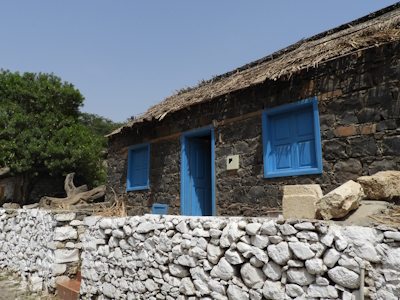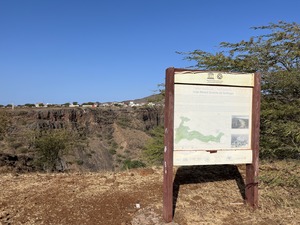Cidade Velha

Cidade Velha, Historic Centre of Ribeira Grande, was a Portuguese colonial settlement that played an important role in the maritime trade of enslaved persons and goods between Europa, Africa and America.
The enslaved were also used to further develop the local colony, which resulted in the birth of Creole culture. Surviving monuments in Cidade Velha from that period include the oldest colonial church in the world, constructed in 1495, and Pillory Square with its ornate 16th-century marble pillar.
Community Perspective: situated on Cabo Verde’s main island Santiago and only 15kms outside of the current capital, the town is easy to reach. Reviewers found no great deal to see, the best-preserved monument being the Fort Real of Sao Filipe, and compared the atmosphere to “a sleepy African, or perhaps more specifically, Brazilian village”. Els explored the Ribeira Grande Valley, also part of the inscribed site, on foot.
Map of Cidade Velha
Community Reviews
Els Slots

Cidade Velha is an easy, short excursion from Santiago’s (and Cabo Verde’s) capital Praia. A bay, a few cobbled streets, remains of Portuguese fortifications and churches – you know what it looks like even before you have seen it. I tried a different approach for my visit and went for a guided hike through the Ribeira Grande Valley. This way I also ticked one of the other activity boxes I had for Cabo Verde: “Do a hike in the countryside” (as the archipelago is known as a hiker's paradise).
When you look at the official map of Cidade Velha WHS, you’ll notice that not only the seaside town is included but also a much larger area inland. The boundaries of the core zone follow the canyon that was carved out by the river Ribeira Grande. This area is linked to a specific part of the site’s OUV: the “acclimatisation and dissemination of numerous plant species between the temperate and tropical zones”. The Portuguese colonists experimented with various crops here in the 16th and 17th centuries, starting unsuccessfully with cereals but later finding out that plants from Africa’s mainland (coconut) and Latin America (maize) did well.
We started our hike in the village of Calabaceira. From there, a marked trail leads down into the valley. The guided hike is labelled as “an easy and accessible path for every hiker” by the tour company, but the volcanic soil is rocky all the time and especially going down you have to stay concentrated so as not to slip.
Already at the start, we saw a troop of Green monkeys (mammal migrants from West Africa); the guide said that they always run away to a higher spot on the cliffs when they see humans on the path – and that is what they did when we passed as well. The views here at the beginning of the trail are stunning as you look into the evergreen valley with a great variation of trees (upper photo). This is in stark contrast to the rest of the island, which is pretty barren in the dry months of winter. There’s a natural spring here that provides water all year for irrigation.
Halfway down the ridge, we came across the first farms. Nowadays most farmers live in Praia and only come during the season to work the land (and return home in the evening). There’s a good variation in crops: two kinds of bananas, mangoes, papaya, tamarind, figs, and berries. The most popular plant however seems to be sugarcane, as it forms the main ingredient of the highly alcoholic drink grogue.
In the valley, we followed the dry river bed (flat, but still a lot of stones!). Here we stopped at a single huge baobab, said to be over 400 years old. Cabo Verde’s baobabs are linked to the visit of Charles Darwin to the island in 1873: his first real “taste” of tropical vegetation, and the longevity of baobabs got him thinking about the age of the earth. The specimen he saw apparently is no longer there, but this one must have been mature at the time and quite a sight as well. Like Darwin, we also saw several Grey-headed kingfishers – it’s funny to encounter a species of this globally common bird family not near water, but behaving the same as always: sit still on a branch and wait until an insect crawls by.
After 4km of walking, which took us 2 hours, we arrived on the outskirts of the town of Cidade Velha. We found a simple distillery squeezing the juice out of the sugarcane to prepare it for being turned into grogue (lower photo). Sugarcane stalks also comprise the traditional material for the roofs of houses, as can be seen in the old street Rua da Banana.
Read more from Els Slots here.
Wojciech Fedoruk

It seems Cape Verde is not a very popular country in this community. It is not surprising since there is only one World Heritage Site and chances for the inscription of the second one (Tarrafal) are vague. But if you do not follow typical beach vacation on Sal or Boa Vista, there is a lot to see and there is a surprising variety of landscapes in this small country.
Cidade Velha, the only WHS of the country, was the first settlement of the archipelago and the first colonial town south of Sahara. The Portuguese, striving for piety up to exaggeration, built here more churches than secular buildings. Some of them, such as Convent of Sao Francisco, or Church of Nossa Senhora do Rosario (the oldest colonial church in the world) are part of the inscription. The other one – Se Cathedral (again the first colonial cathedral) is nowadays nothing but ruins. All inscribed properties are withing the walking distance and can be convered in a couple of hours. The best preserved is Fort Real of Sao Filipe, a stronghold built on the steepy hill nearby (the pave is very bad and we almost surrendered descending it with baby stroller).
Cidade Velha lost competition with Praia and now is nothing but a small but nice village, perfect for a half a day trip from the capital. After visiting the inscribed sites it is worth to sit in one of the restaurants in the center, with a sea view from one side, and public pillory (another inscribed site) from the other.
Cidade Velha is easy to reach with public transport. Aluguers (shared taxis) go frequently from Praia and the price for about an hour trip is something like 2.5 EUR one way. Be careful – aluguers can be extremely crowded, with many more passengers than sits. But it is also part of the fun…
Solivagant

So Durian’s “inside information” suggests that “Cidade Velha, Ancient Ribera Grande” in Cape Verde might be proposed for inscription in 2009 (see Forum “Nominations for 2009”). For the benefit of my “Visited count” I certainly hope so, since I visited it in April 2003 – but without any expectation that it might EVER be a WHS! In fact Cape Verde only got round to proposing a T List in 2004. Interestingly, however, this small island country had tried to get this very site inscribed many years earlier. I quote verbatim the minutes of the Bureau meeting at Paris in July 1992 “The Bureau considered that, in spite of its indisputable historic value, the property did not meet the criteria for inscription on the World Heritage List”. And at the WHC itself at Santa Fe in December 1992 “The Committee noted that there was no protection or management plan for this cultural property and that it did not meet the criteria for inscription on the World Heritage List”. Well that’s pretty clear then isn’t it! But, as we have noted before, “No” doen’t have to mean “No” where the WHC is concerned! Political imperatives can change a “no hoper” into a “star” and a bit of coaching in the preparation of good (and voluminous) documentation from experts in the field can help overcome doubts!
Well – what is there at Cidade Velha? It is situated on Sao Tiago, the largest island of the Cape Verde archipelago – and also the most “African”. We arrived by boat into the capital – Praia. Cidade Valha is situated 15 kms outside and was the original capital. Ribera Grande” is a deep valley at the bottom of which nestles the village of Cidade Velha (c 2550 people) – which was originally named after the valley until the passage of time and the move of the capital to Praia justified the name change. On the desert plateau, 100 metres above, is the Portuguese “Fort Real de Sao Filipe” dating from 1590 (built, perhaps, in response to the town’s sacking by Sir Francis Drake?). This building was in excellent condition when we were there, having been restored in 1999 with Spanish help. It is pleasant enough and commands fine views over the valley and the coast – but the List isn’t short of Portuguese forts – see Connections!
Cidade Velha is significantly older and more interesting – at least for its historic position in 15th century exploration and settlement. The Cape Verde islands were uninhabited when discovered around 1460, settlement began in 1466 and Columbus and da Gama visited this very port on their voyages of exploration. The church, constructed in 1495, is apparently regarded as the “oldest colonial church” in the world (But I wasn't aware of this when I saw it and can't say that I particularly remember the building other than its general existence!). Slavery started very early as the Portuguese explored Africa and the islands became both a destination for slaves and an intermediate “warehouse”. Along with the Fort and the Church the other main “historic sight” was that of a post in the main square to which slaves were once chained. But the atmosphere which came across to me during a half day visit to the fort and village was more that of a sleepy African, or perhaps more specifically, Brazilian village (photo).
So, in conclusion, there is not a great deal to “see” in terms of major or outstanding sights. The importance, such as it is, lies in Cidade Velha’s early role in European expansion:- the route to Africa and the Americas, slavery, settlement of new lands, the creation of a Creole nation etc. There is plenty there for UNESCO to view with satisfaction and, provided the concerns expressed in 1992 about the "lack of a Management Plan” etc have been overcome, I would expect this site to be viewed favorably, coming as it does from a small “African” country with no other inscribed site. The more interesting questions might be why it was not regarded as meeting the criteria in 1992 and whether/how interpretation of the criteria has altered and developed during the intervening years!
Community Rating
- : Christoph João Aender
- : Els Slots Roger Ourset Alexander Barabanov Reisedachs Tony0001
- : Persian Globetrotter Dimitar Krastev Daniel Gabi
- : Pierre T Jon Opol Mikko Philipp Leu Stijn Randi Thomsen Kevin247 Svein Elias
- : Wojciech Fedoruk Solivagant Mahuhe Bill Maurmann
- : Szucs Tamas
- : Christravelblog
Site Info
- Full Name
- Cidade Velha, Historic Centre of Ribeira Grande
- Unesco ID
- 1310
- Country
- Cabo Verde
- Inscribed
- 2009
- Type
- Cultural
- Criteria
-
2 3 6
- Categories
- Urban landscape - Colonial
- Link
- By ID
Site History
2009 Advisory Body overruled
ICOMOS suggested Referral, but WHC decided to Inscribe
2009 Inscribed
1992 Rejected
No protection and does not justify WHS
Site Links
Unesco Website
Related
In the News
Connections
The site has 31 connections
Art and Architecture
Constructions
Damaged
Geography
History
Human Activity
Individual People
Religion and Belief
Timeline
Trivia
WHS Names
World Heritage Process
Visitors
70 Community Members have visited.

